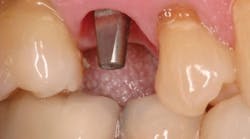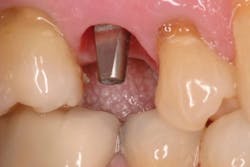Anatomically and esthetically predictable Class II composites
By Gary M. Radz, DDS
For more on this topic, go to www.dentaleconomics.com and search using the following key words: Class II composites, Triodent V-ring system, V3 ring, esthetics, Dr. Gary Radz.
For the past 16 years of my career, 99.9% of the Class II restorations I have placed have been in composite. Many dentists in the U.S. have been making this transition to less amalgam usage. Patient demands and improvements in material have led to this trend of more composites being placed.
The improvements of the composite materials and bonding agents have allowed dentists to be more confident in using resins as a restorative material. However, the one challenge and frustration shared by many dentists is the inability to create a tight and anatomically correct interproximal contact with their Class II resin restorations.
Many have attempted to use the matrix/wedge techniques that work well for amalgam, but are unpredictable at best when applied to a material – composite – with different handling properties.
Dr. Gordon Christensen and others have noted that the proper establishment of Class II proximal contacts has been a recurrent and common problem associated with composite resins.
Through the years there have been many different instruments and techniques developed to try to overcome this issue. I have tried many of these instruments and techniques through the years with varying levels of success.
Material manufacturers have also recognized this issue. This can be demonstrated with the development of the "packable" or "condensable" line of composites that many manufacturers have created over the last 15 years.
The idea is to create a more dense material that handles like amalgam in hopes it will maintain its shape as the resin is "condensed" to place and allow for an easier, more predictable and acceptable proximal contact. Some dentists successfully used these materials, while others still found themselves without a solution to their problems.
Many experienced dentists have by now, in 2010, found a combination of materials, instruments, and techniques that allow them to frequently establish clinically acceptable proximal contacts and contours with their Class II composites.
Until recently I had my system in place; it required three different types of composite resins, use of one of four different types of matrices (depending on the clinical situation), a specific type of wooden wedge, and a specific hand instrument.
If I used all of these, 80% to 90% of the time I got a contact that I found acceptable. This came at a cost. First of all, it took a lot of time and inventory, which cost me money. Secondly, I found myself dreading a Class II on the schedule.
Finally, even though I have two talented and well-trained expanded duty assistants who can legally do a Class II composite, I never allow them to do it because the final success of the restoration is too technique sensitive.
A year and a half ago everything changed about how I do and feel about Class II composites. That is when I was introduced to the Triodent V-ring system. This sectional matrix system has been designed in such a way as to make Class II composite resins far easier and more predictable.
The following case study shows this sectional matrix system in action to demonstrate its ability to make the clinician's job easier and provide for a superior final restoration.
Case Study
A 40-year-old patient presented with a 20-year-old Class II amalgam restoration that was breaking down at the marginal ridge (Fig. 1).
There was a small area of decay in the distal pit that was identified with the DIAGNOdent (Kavo). The patient was advised of the issue. Before we discussed restoring this restoration, the patient requested that we fix this tooth using a tooth-colored material.
As the area to be restored was still relatively small, a direct Class II composite was indicated. The area was anesthetized and a rubber dam was placed.
The old restoration was removed. A small area of decay was removed. The preparation was checked using a caries detector (SEEK, Ultradent). The distal pit was opened up using very small diameter "micro-prep" diamond burs (Axis) (Fig. 2).
The tooth was now ready to be restored. A Triodent sectional matrix was placed and held in place with an appropriate sized wedge. Then the V3 ring (Triodent) was placed (Fig. 3).
There are two things to note about the Triodent ring. First is its thick and robust nature. This allows for the ring to not only fit snugly into place, but the force generated by the ring creates separation between the molar and premolar.
This mild force allows the teeth to move apart temporarily, giving the ability to create a tight contact upon release of the pressure via removal of the V3 ring. Second, the Teflon tips of the ring allow for anatomical contouring of the matrix at the line angles, which helps to develop and define the final axial contours.
A self-etching bonding system (All-in-One Bond, Kerr) was used as the adhesive system. An initial liner was placed using a flowable composite to seal the apical portion of the proximal box to prevent any microleakage and seal the restoration (Fig. 4). The same flowable composite was used to restore the small pit preparation in the distal pit.
Finally, the restoration was completed using two increments of an A1 shade of a new microhybrid composite (Nuance, Discus) (Fig. 5). This material has optical properties that allow the dentist to use only a single shade, yet achieve an optical effect that allows for blending of the composite with the surrounding tooth structure, thereby achieving a "chameleon" effect and developing a highly esthetic final restoration.
Using an anatomically shaped diamond finishing bur (Raptor, Axis), the initial anatomy was created in the restoration while the rubber dam was still in place (Fig. 6).
With the rubber dam removed, the occlusion was refined in the restoration. This was followed by polishing with a series of rubber points (Jiffy, Ultradent) (Fig. 7, see page 74).
Finally, the interproximal contact was verified with dental floss. As has been consistent with the use of the V3 matrix system, the contact was virtually perfect.
Triodent V3 is the answer
Class II restorations are some of the most common restorations placed in today's dental practice. With the appropriate materials and techniques, these restorations can be completed efficiently and be clinically acceptable for a long time when done correctly.
With this matrix system I enjoy doing Class II restorations, and I am also able to delegate this responsibility to my expanded duty dental assistants. They are routinely able to create clinically excellent Class II resin restorations.
The Triodent V3 matrix system can help with the most challenging and time consuming aspect of Class II resins – proper interproximal contact and anatomy.
References available upon request.
Dr. Gary Radz maintains a private practice in downtown Denver, Colo. He is an associate clinical professor at the University of Colorado School of Dentistry. For more information on Dr. Radz, go to www.garyradz.com.







